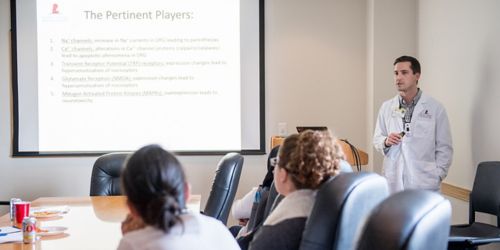St. Jude Family of Websites
Explore our cutting edge research, world-class patient care, career opportunities and more.
St. Jude Children's Research Hospital Home

- Fundraising
St. Jude Family of Websites
Explore our cutting edge research, world-class patient care, career opportunities and more.
St. Jude Children's Research Hospital Home

- Fundraising
When pain is the real deal

Whether it be the result of illness and treatment, or pain from shots or giving blood, pain is a constant companion for children fighting cancer. The St. Jude Pain Board meets monthly for clinicians from myriad departments to discuss ways to manage patient pain.
We all know what it’s like to get a shot in the arm. There are a few seconds of nervous anticipation, followed by the fleeting sting of the needle. The pain we experience depends on several factors, but there’s no doubt it’s there. As we get older, the pain may not bother us as much. For kids, it can ruin their day.
Pain comes in many forms for St. Jude patients, who can experience short bouts related to procedures such as needle sticks or chronic pain that stems from their illnesses.
Every patient we see will experience a needle stick at some point, whether it’s from having blood drawn, receiving medications or preventive shots. Those few seconds of pain might not seem much, but what if there were a way to lessen that painful experience and other similar experiences? At St. Jude, we are examining questions like this to combat the pain issues that affect our patients.
Our Pain Management Service already works hard to manage complex pain problems by collaborating with patients’ primary health care teams. This team often consists of anesthesiologists, psychologists, clinical nurse specialists, pharmacists, physical therapists and child life specialists.
We wanted to take it a step further and look at ways to continue to include a variety of disciplines while looking at new interventional techniques and approaches. So, we launched the St. Jude Pain Board in February 2017 to enhance our Pain Management Service’s efforts and increase awareness among our clinicians.
The idea of a Pain Board originated from our Interventional Radiology team, which is part of the St. Jude Diagnostic Imaging Department. Our first meeting focused on identifying overlaps and gaps in pain coverage as well as determining the role of interventional radiology in pain management at St. Jude.
As health care providers from various backgrounds and practices, we sought a way to combine our collective knowledge to attack the same problem and seek solutions. This is similar to a Tumor Board, where health care professionals of various disciplines gather to devise a course of action in treating a tumor.
The initial Pain Board meetings were a success. Our goal was and continues to be to examine hard-to-treat pain syndromes, develop a standard approach to managing various pain conditions and find ways to maximize our resources.
Each monthly Pain Board meeting highlights a different pain-related issue. We’ve covered a variety of topics such as mucositis, headache, chemotherapy-induced neuropathic pain, the role of biofeedback and hypnosis, and needle stick pain.
The needle stick pain presentation included clinicians from multiple areas of the hospital who had some open, honest and resourceful conversations. Presenters from our Child Life, Psychology and Nursing departments shared their strategies and ideas.
We look to cover a variety of topics in the coming months to effectively assess our patients’ needs as we work to find more and better ways to ease pain at St. Jude.






